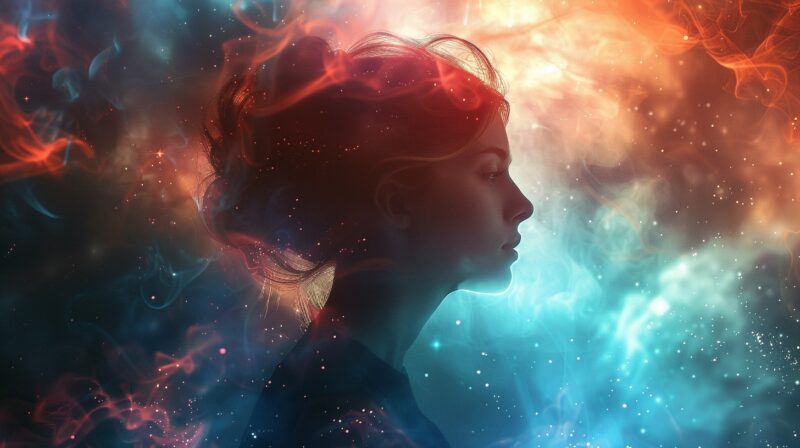A precognitive dream is a type of dream that comes true as a future event. It is also known as Déjà Rêvé (Art Funkhouser, Dr. Vernon Neppe). It can bring about the same sensations associated with Déjà Vu such as the Déja Vu Aura, goose-bumps etc.
Key Takeaways
- Precognitive dreams are dreams that predict future events, ranging from symbolic to literal representations.
- Types of precognitive dreams include Symbolic, Literal, 3rd Person, and Lucid, each offering different perspectives and levels of clarity.
- Historical references to precognitive dreams, such as in the “Epic of Gilgamesh” and Aristotle’s writings, show their long-standing intrigue.
- Theories suggest quantum mechanics and the nature of consciousness may explain the phenomenon of precognitive dreams.
Types of Precognitive Dreams
- Symbolic Precognitive Dream.
- Literal Precognitive Dream.
- 3rd Person Precognitive Dream.
- Lucid Precognitive Dream.
Symbolic Precognitive Dream
Dream symbolism abstracts the precognitive information and generally is not realized up until the actual event. This can be a very difficult type of dream to identify as a type of precognitive dream, however certain symbols in the dream can match or greatly exaggerate the future event when it actualizes. The accuracy and quality of this type of dream should be considered of a low grade type of precognition.
Literal Precognitive Dream

From a first-person view, this type of precognitive dream in literal detail. What you sense, think and feel in the dream can actualize in the future-tense when the dream actualizes. This dream can bring about a Déjà Vu aura however linking the memory of the déjà to a dream is what classifies this type of dream as Déjà Rêvé.
3rd Person Precognitive Dream
From a third-person vantage point, this type of precognitive dream can take on both symbolic and literal similarities however does not suggest that the information being observed will occur from a first-person point of view.
Lucid Precognitive Dream
A lucid dream is a dream where a person is awake and realizes that they are dreaming. This alert and awakened focus state also can emerge within the phenomena of precognitive dreams. This type of precognitive dream can have an even more pronounced déjà vu aura then a non-lucid precognitive dream.
Robert Waggoner explains there are two types of lucid precognitive dreams: Active and Ambient. In an active lucid precognitive dream, the dreamer actively tries to engage the precognitive dream, where in an ambient lucid dream the dreamer passively observes the dream remaining within the usual dream flow.
History

Babylonian “Epic of Gilgamesh” a Sumerian Poem suggests precognitive dreams in tablet 1 where Gilgamesh dreams about the imminent arrival of two companions, or the ominous dream received by Enkidu on tablet 6. The “Epic of Gilgamesh” is one of considered one of the oldest works of literature and predates biblical text at approximately 2150BC and could be one of the earliest suggestions of precognitive dreams.
Aristotle published a paper entitled “On Prophesying by Dreams” written in 350BC which questions with skepticism the validity of claims by those who say they have dreams of the future. He does not completely refute the notion of precognitive dreams, however understands that much of what is dreamed could be coincidence.
It’s clear that ancient Greeks subscribed to prophecy as evident in Homer’s “Iliad” and “Odyssey” where in Cassandra is granted the gift of prophecy by Apollo. The Greek God Morpheus resides in a land of Dreams somewhere in the Underworld where two gates exist, one that sends false dreams through the gate of ivory, and the other that sends prophetic dreams gate of horns.
Theory
Answers to why precognitive dreams occur may lie in quantum mechanics and the effects on consciousness. If future information exists, as suggested by people who claim to experience precognition, certain theories in Physics might apply, for example Hugh Everett many-worlds interpretation , which is an evolving theory stemming from Erwin Schrödinger’s cat paradox .
In a quantum view of a many-world system, every possible past, present and future probability could theoretically exist as probability. We know through quantum superposition that a particle can exist in every possible state until observed.
Physicists are just starting to understand quantum information, and if this information is non-linear and existing within an astronomical data-set, it is possible that the Universe has organized into a complex information system and data structure that had per-populated itself with a myriad of probability that may exist in an astronomical scale.
Stuart Hameroff proposes that the human brain is both a Neurocomputer and Quantum computer . The link to the computational nature of the brain and how quantum mechanics may link to consciousness could explain that some type of entanglement and superposition affects human consciousness.
Pemrose and Hameroff have discerned that the brain uses coherent photons as part of the brain mechanics and is used to preform information processing. Photons contribute to what we view as consciousness, and consciousness itself may have quantum states that through time and research we can unravel.
The Universe itself can be viewed as information that our brains must access and render into a model that we call subjective reality. A unique first-person vantage point within an objective dataset. Regardless of how objective reality is, it must always be subjectively experienced by a conscious observer.
The nature of quantum mechanics is revealing through superposition that matter and energy could also be viewed as information. If we consider the Universe as an information system, then past/present/future could exist in every possible conceived state as probability and data. Digital Physics, first termed by Edward Fredkin has emerged with serious considerations that Reality itself could be computative in nature, a Universal computer so to speak.
This idea is supported by Tom Campbell “My Big Toe”, Brian Witworth “The Physical World as Virtual Reality”, Seth Lloyd “Programming the Universe”, Stephen Wolfram “Cellular Automata”, Max Tegmark “Mathematical universe hypothesis” and the list goes on.
In Brian Witworths work, there is a quote that seems to resonate with the nature of precognitive dreams,
“This makes this world a recursive interface, that both sends to and receives from itself. If so, it is like no other information interface that we know.”
It is in this quote and within the nature of precognitive dreams that we may see the emergence of the recursive feedback in the form of probable reality in a dream, to the actualized reality when the dream comes true. It could be suggested that the precognitive dream itself is a form of reality per-programming within this recursive interface, and the actualization of the dream is the feedback within the greater system.
How is this possible? What are the mechanics that drive this system and allows for non-linear, non-localized dreams to actualize into reality? At this point, we have theories and ideas evolving from those who understand and see a relationship between consciousness and reality.
If we look again at physics, there is another anomaly that suggests the observe affects wave-function collapse:
“Wave function, initially in a superposition of different eigenstates, appears to reduce to a single one of the states after interaction with an observer. In simplified terms, it is the condensation of physical possibilities into a single occurrence, as seen by an observer.”
The observer effect brings about the measurement problem in Quantum Mechanics and stirs the debate if wave-function collapse occurs at all, however the Double-slit experiment demonstrates wave / particle duality and further entangles the observer into the role of one who collapses wave function.
This is an interesting enigma within science, it suggests a link between the observer and the observed. That deterministic probability is being actualized as the observer renders reality through the act of collapsing wave-function and probability. It seems like a stretch to the imagination but we are talking about precognitive dreams here.
Dreaming for the most part is a passive experience where we project our thoughts, ideas and emotions into a virtual 3D world based on the principles of organized thought.
At some point within this creative process of dreaming, certain dreams appear to qualify as “precognitive” in nature. A seeming unknown potential that does not become apparent to the dreamer, until the dream actualizes and the individual is left with the realization that what was once dreamed of, is now actual.
Anatomy of a Precognitive Dream

If we take for face value what a precognitive dream is, it is a type of dream that has future potential. In order for such a dream to come true, it must actualize into an event in physical reality. In the case of a literal precognitive dream, the dream is observed from a subjective vantage point, the physical event that the dream actualizes into must also be perceived from the same subjective vantage point.
This suggests that reality exists in two states: A state by which a person can dream of a future event, and a state where this event actualizes into a physical event. It suggests there is a direct relationship between what is dreamed, and what is later experienced in reality.
In a linear context, the precognitive dream pre-dates the physical event that it represents. In looking at the origin of the physical event. We have an answer to a Causality Dilemma known as, “What came first, the chicken or the egg?” In the case of “What came first, the dream or reality”, in the case of precognitive dreaming, the precognitive dream came first.
Precognitive dreaming is in fact a paradox that exists within the subjective vantage point of certain observers who have had enough memory, awareness and perception during a certain dream that qualifies as a precognitive event. What also makes this unique is that people who often have precognitive dreams, have a varying degree of frequency, clarity and quality. It can range from one precognitive dream in their entire life, to many.
Then there are those who do not have any precognitive dreams, they may not have first-person experience with this paradox to even begin accepting that such a phenomena is real and possible.
For the most part, these people are skeptical of others who claim they have. It is up to you to decide what dreams you have had, that qualify as precognitive or not. You can only know through the process of actualization if a dream has any precognitive worth.A reason as to why this is, (Why some do and some don’t) may have been answered by Tom Campbell who wrote the trilogy entitled, “My Big Toe”, where he describes the Psi Uncertainty Principle.
The Psi Uncertainty Principle allows for individual growth in areas that may be construed as paranormal or spiritual, without affecting or having impact on others who are not ready to grow in certain areas. Precognitive dreams certainly fit within the described theory as something that affects individual growth more so then affecting many with any mass effect.
FAQ
What is a precognitive dream?
A precognitive dream is a dream that appears to predict or foretell a future event before it happens.
How can I tell if I’ve had a precognitive dream?
If the content of a dream later matches or closely resembles an actual event, it may have been precognitive. The realization often comes after the event occurs.
Are all dreams about the future considered precognitive?
No, only dreams that accurately predict specific future events are considered precognitive. Many dreams about the future are speculative or imaginative rather than precognitive.
Is there scientific evidence for precognitive dreams?
While there are anecdotal reports and some studies exploring the phenomenon, precognitive dreams remain a topic of debate and research within the scientific community.
Can I increase my chances of having a precognitive dream?
While there’s no proven method to increase the likelihood of precognitive dreams, maintaining a dream journal and practicing mindfulness or meditation may enhance dream recall and awareness

